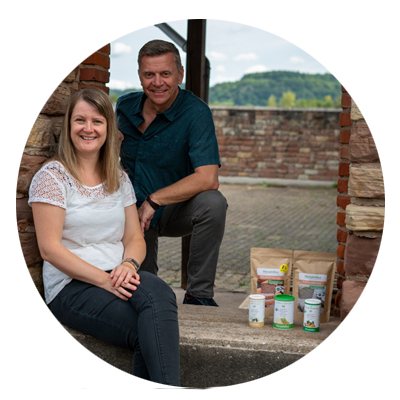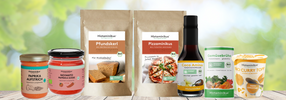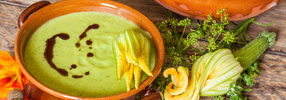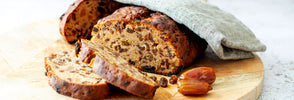
Intestinal skin axis
Many now know that our intestine and our brain are closely connected to the so-called intestinal brain axis. But did you know that there is also an intestinal skin axis? This connection shows that our skin health is directly influenced by our intestinal microbioma - and vice versa. But how exactly does it work? And what does that mean for people with skin problems such as neurodermatitis, acne or generally sensitive skin?
How your intestine communicates with your skin
The intestinal skin axis is a complex network through which bacteria in our intestine get in touch with the skin. Dear bacteria interact with the intestinal mucosa and release molecules that get into the bloodstream. These substances can then influence different processes in the skin - such as the immune system or the skin barrier. Nutrition naturally plays a major role: everything we eat is digested in the stomach and small intestine and distributed through the blood in the body. Vitamins and nutrients get into the skin cells and support skin health. At the same time, excess or harmful fabrics are excreted over the intestine or skin. Our skin bacteria also feed on these fabrics. They use water, sugar, proteins, fats and acids from our sweat and our sebum production. Some bacteria even use urea to gain nitrogen.
If your intestinal health gets out of balance, it can have a quick impact on your skin - it becomes more restless, more sensitive or shows more impurities. But what exactly happens in your body? If your intestine is no longer working optimally, toxins that are normally excreted can stay in the body and unload themselves through the skin - this can significantly burden the complexion. At the same time, the intake of important nutrients and vitamins is disturbed, which your skin urgently needs to stay healthy and radiant. In addition, a stressed intestine produces increased inflammation substances - and these can additionally cheer on skin diseases such as acne, neurodermatitis or rosacea (chronic inflammation of the facial skin).
No wonder that you can also get symptoms on the skin with histamine intolerance! If histamine is released from the mast cells, it also makes the blood vessels more permeable. This can lead to whispering, itching, redness and other skin problems.
Typical skin symptoms in histamine intolerance:
🟢 Flush (seizure -like violent blushing of the face), reddening of the skin
🟢 Nessel addiction & whisper
🟢 neurodermatitis
🟢 eczema, itching & dry skin
🟢 sweating
🟢 blemishes, rash & sun allergy
🟢 edema (swelling)
Certain skin problems are particularly common with the intestine. In acne, the intestinal flora is often disturbed - this can affect hormonal balance and inflammation. Neurodermatitis is often tightened by an overloaded immune system, for example in food intolerance or intestinal inflammation. Rosacea (chronic inflammation of the facial skin) often occurs together with irritable bowel - the inflammation in the intestine also shows on the skin. And with psoriasis there are clear parallels to chronic inflammatory bowel diseases.
Share information about your brand with your Customers. Describe A Product, Make Announcements, Or Welcome Customers to your Store.
Skin and intestine in traditional Chinese medicine
If your intestine is crazy, it often shows itself on the skin - and vice versa. Exactly this context has known the traditional Chinese medicine (TCM) for thousands of years. Even if there was no term like "microbioma" at the time, it was already very well observed that skin and digestion are inseparable.
"When someone comes to me with skin problems, I always ask about digestion," says Johannes Bernot, alternative practitioner and TCM therapist from Hamburg. Sounds unusual at first? It is not at all. Because dry skin means for the body: liquid is missing. And then your large intestine tries to pull even more water out of the chair - which often leads to constipation. The other way around, diarrhea is often a sign that the body needs a valve for inflammatory skin diseases - almost an attempt to get rid of the inner pressure.
Incidentally, the skin in the TCM is not just what we see. Also mucous membranes - for example in the intestine, the urinary tract or the airways - are also part of the outer body surface. They form a protective barrier against intruders, similar to our visible skin. FUN FACT: The same medicinal herbs that help with a cold (i.e. support the lungs) often also work with bladder infection. This is logical for the TCM - because lungs, skin, bladder and intestine are energetically connected.
Maintain the skin from the inside
In the TCM, skin problems are therefore not only treated externally, but also from the inside - via the blood that circulates directly under the skin. Especially with dry skin, it is worth looking at blood quality. According to TCM, a slight “bloodless” can be the cause - and can be regulated with Chinese herbs and a suitable diet.
Share information about your brand with your Customers. Describe A Product, Make Announcements, Or Welcome Customers to your Store.
Image with text
You are what you eat!
Our mission is to develop delicious food according to in -house recipes that are not only low -histamine and gluten -free, but also taste really tasty.
We'll tell you how you can support your skin and intestine:
Less sugar, less animal fat, fewer dairy products and red meat - but a lot of fresh vegetables, berries, whole grains, nuts and seeds. Such approaches to nutrition are increasingly recommended not only in the TCM, but also in general medicine. Many patients with neurodermatitis report that their symptoms have improved significantly through this diet - often almost completely disappear.
What also love your good intestinal bacteria? Fiber! Especially the soluble, which you can find, for example, in vegetables, fruit and whole grain. Bitter fabrics - for example from a distor of the Maria or Artichoke - also get your digestive system going. And an intestine that runs well often makes your skin shine.
What can also help you:
• Vitamin A, B2, Niacin & Biotin - for healthy mucous membranes.
• Vitamin C, E & Biotin - support your skin from the inside.
• Zink & copper - protect the skin cells, support regeneration and ensure an even complexion.
Vitamin C also not only helps with collagen formation, which is good for connective tissue. It is also an extremely effective antihistamine!
Regular intestinal cleaning (link) also relieves your intestine and flushes out toxins. This also relieves the liver and can meet your detoxification work. Note: When your detoxification organs are overloaded, the liver and kidney are overloaded, the poisons come out of the skin and are noticeable as eczema, dry skin, skin exchanges, etc. It is therefore important that your detoxification organs are supported and maintained.
Share information about your brand with your Customers. Describe A Product, Make Announcements, Or Welcome Customers to your Store.
In summary: If you do good to your intestine, it also thanks you to your skin - with more radiance and less stress.
Share information about your brand with your Customers. Describe A Product, Make Announcements, Or Welcome Customers to your Store.
Collapsible content
SOURCES

FROM THOSE AFFECTED FOR THOSE AFFECTED
We are Thomas and Michaela Zinser, founder of Histaminikus.
Because of the own histamine intolerance of Michaela and our son, we founded Histaminikus. The frustration does not find any suitable histamine food has spurred us to develop low -histamine food.
We would like to give you back a piece of quality of life. Feel free to look around with us.
Kind regards
Thomas and Michaela







